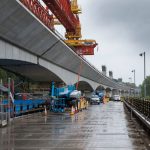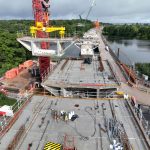 HS2 Colne Valley Viaduct 40-metre span has been completed and following the viaduct construction, it will be the longest railway bridge in the UK, stretching for more than 3.4km across the Grand Union Canal, River Colne, local roads and a series of lakes on the outskirts of London between Ruislip and the start of the Chiltern tunnels.
HS2 Colne Valley Viaduct 40-metre span has been completed and following the viaduct construction, it will be the longest railway bridge in the UK, stretching for more than 3.4km across the Grand Union Canal, River Colne, local roads and a series of lakes on the outskirts of London between Ruislip and the start of the Chiltern tunnels.
To allow for the gentle curve of the viaduct, each of the one thousand segments that form the arches and deck are slightly different, and all are manufactured at a temporary factory set up close by, with direct access to the M25.
Most of these segments are slotted into place by a giant 700-tonne ‘launching girder’, the only one of its kind in the UK. But the engineers used a different approach at Moorhall Road to allow the closure to coincide with the school summer holidays when traffic is lighter.
Construction of the HS2 project, which is designed to improve rail links between London, Birmingham and the north, will help boost the economy and provide a low carbon alternative to car and air travel. It is approaching the peak of construction activity, with more than 29,000 jobs supported by the project across the UK.
“HS2 will transform journeys across the UK, boosting the economy and unlocking more space on our existing rail network. But it’s also important that we minimise disruption during construction. That’s why we brought forward construction of this span, so it could be done during the school summer holidays when we knew traffic would be lighter,” HS2 Ltd’s Senior Project Manager, Billy Ahluwalia, said.
HS2 Colne Valley Viaduct is being built by Align JV, a team made up of Bouygues Travaux Publics, Sir Robert McAlpine, and VolkerFitzpatrick.
Set low into the landscape, the widest spans are reserved for where the viaduct crosses the lakes, with narrower spans for the approaches. This design was chosen to enable views across the landscape, minimise the viaduct’s footprint on the lakes and help complement the natural surroundings.
The design was inspired by the flight of a stone skipping across the water, with a series of elegant spans, some up to 80m long, carrying the railway around 10m above the surface of the lakes.
Share on:






